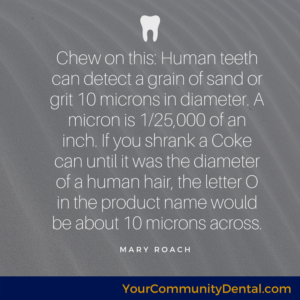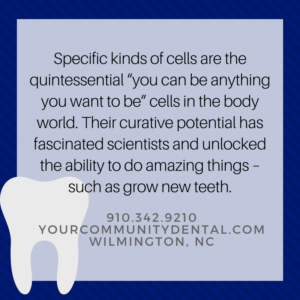Dental Care’s Past & Future Will Make You Appreciate Your Teeth
Healthy teeth are easy to take for granted, yet roughly 120 million people in the U.S. are missing at least one tooth, and more than 30 million Americans have no teeth at all. Good dentistry helps hide these facts. As much as 90 percent of the people who are lacking teeth wear dentures, according to the American College of Prosthodontists. Approximately 35 percent of patients at Your Community Dental have dentures or partials, said Tammy Howard, practice administrator.
The numbers are expected to grow over the next 20 years. Contrary to popular belief, tooth loss is not always the result of poor oral care. People lose teeth for a variety of reasons:
• Injuries: Think of athletes who suffer a blow to the mouth (boxers, hockey and basketball players come to mind), but injuries from falls or accidents can happen to anyone.
• Disease: Yes, there is periodontal disease, which can be due to poor oral care; however, individuals might also be suffering from oral cancer.
• Wear and tear: And, of course, as we age, some body parts (including teeth) just deteriorate.
Dentistry’s History
So how did dentistry come to address the need to treat people who have lost teeth? An ancient Egyptian named Hesy-Re in 2600 BC was the first documented dentist; however, we do not see the earliest examples of dentures until approximately 700 BC. Etruscans – an ancient civilization in central Italy that pre-dated the Romans – built dentures with human and/or animal teeth, fastened together with gold bands.
Dentistry is even found in the writings of Hippocrates and Aristotle – an ancient Greek physician and scientist respectively – with details regarding “the eruption pattern of teeth, treating decayed teeth and gum disease, extracting teeth with forceps, and using wires to stabilize loose teeth and fractured jaws.”
The biggest differences between dentures of today and dentures from the Middle Ages lie in the materials used. Dentures made of ivory harvested from elephants, walruses, and hippopotamuses became quite popular during the 1700s. Teeth from other animals as well as human teeth from cadavers or poor people who sold their teeth for money also were used to make dentures.
“In 1723, Pierre Fauchard, a French surgeon credited as the Father of Modern Dentistry, published his influential book, The Surgeon Dentist, a Treatise on Teeth, which for the first time defined a comprehensive system for caring for and treating teeth,” according to the American Dental Education Association. ”Additionally, Fauchard first introduced the idea of dental fillings and the use of dental prosthesis, and he identified that acids from sugar led to tooth decay.”
A pharmacist invented the process of making porcelain dentures in 1744, but the forms shrank during the firing process that hardened molds. It was another Frenchman, Nicholas Dubois de Chemant, who refined the process. The British Dental Association provides a comical, historic illustration of de Chemant from 1811.
By the 1800s, a silversmith named Claudius Ash was able to fuse porcelain onto a gold base, which made the dentures not only look more realistic, but also have a more durable fit. And for the record, none of George Washington’s teeth were made of wood.
Making Over Your Mouth: How Dentistry is Moving Beyond Dentures to Grow New Teeth
Although dentures are far better than those of a few generations ago, complications and discomfort can still arise from wearing them, such as difficulties chewing or speaking if the dentures are not fitting properly. More serious complications could include irritation or infection of the mouth and gums. Proper denture care helps ensure a healthy mouth and dentures that will last. Recommended denture care tips include:
- Clean dentures at least once daily with a commercial denture cleaner, toothpaste or mild soap.
- Never soak dentures in hot water, never use abrasive household cleaners or bleach, and never clean the dentures while they are in the mouth.
- Keep dentures in water or a denture cleaning solution when not in use. It is important that the dentures don’t dry out.
- Denture adhesives are not adequate solutions for dentures that do not fit properly. If your dentures do not fit well, consult your dentist, as you may need have the dental appliance replaced.
What about routine dental visits for a person who wears dentures or a partial?
“Obviously, a person with full dentures doesn’t need to come to the dentist for a bi-annual cleaning, but we do recommend an annual exam so we can evaluate the patient’s gums and overall oral health,” Howard said.
A bi-annual check is strongly recommended for partials.
“If you have a partial, every six months you should have a routine cleaning and exam. This is important because we want to make sure the existing teeth remain healthy and strong to support the partial,” Howard said.
Teeth from a Test Tube?
 Specific kinds of cells are the quintessential “you can be anything you want to be” cells in the body world. Their curative potential has fascinated scientists and unlocked the ability to do amazing things – such as grow new teeth.
Specific kinds of cells are the quintessential “you can be anything you want to be” cells in the body world. Their curative potential has fascinated scientists and unlocked the ability to do amazing things – such as grow new teeth.
In very basic terms, these specific cells hang out in the human body and wait for something to tell them what they need to be. If harvested before having been given a working assignment, these cells can be manipulated to become something specific – like the tissue that forms an organ. Bone marrow transplants are one example of using these kinds of cells. The only difference is from where the cells are harvested.
In tooth bud research, researchers direct these cells to form into tooth buds. If you’ve ever seen a baby teething, you’ve seen a tooth bud. These tooth buds are what grow into teeth. The cells that can form tooth buds require the perfect balance of growth hormones, nutrients, and timing in order to develop properly. They cannot develop in a lab in a typical petri dish.
In order for the these kinds of cells to develop into tooth bud tissues, they must be in an environment conducive to their growth. Specifically, they need surroundings that simulate the early stages of pregnancy.
Researchers have successfully developed tooth buds and implanted them in jaws of laboratory animals. These implants have then grown early-stage adult teeth. The dental research community has entertained the idea of regenerating new teeth from stem cells since the 1990s. Today, several scientists are conducting tooth bud research. At the forefront of the research are the following:
- Pam Yelick, a professor of orthodontics and director of the division of craniofacial and molecular genetics at Tufts University
- Jeremy Mao, a professor of dental medicine at Columbia University
- Edward V. Zegarelli, a professor of biomedical engineering, also at Columbia University
Although the results have seemed largely positive, experiments have not yet entered human trial. Tooth buds for the average dental patient remain a promise of the distant future.
